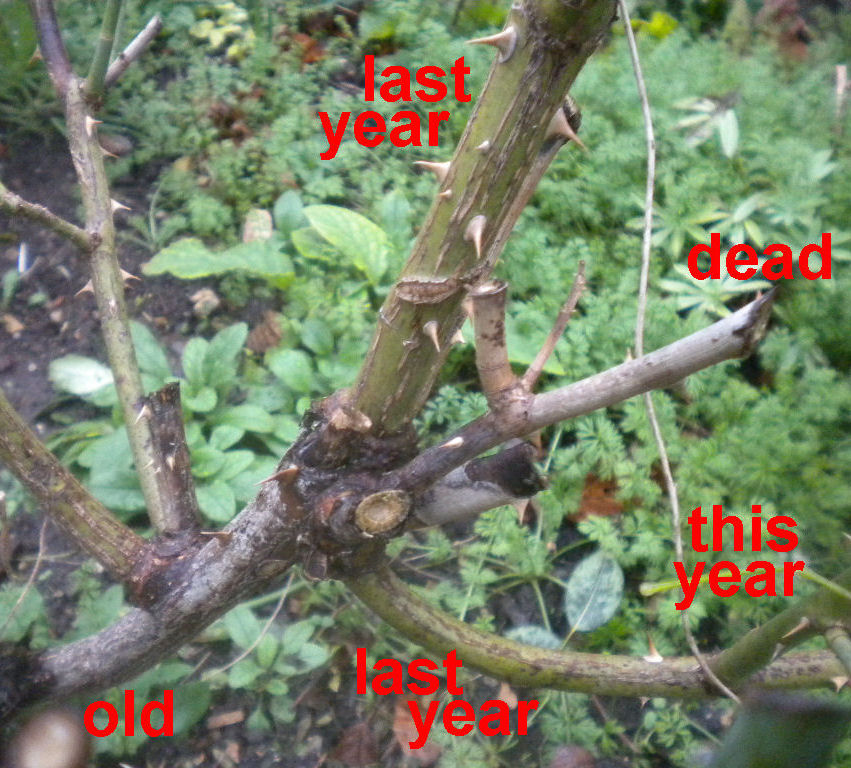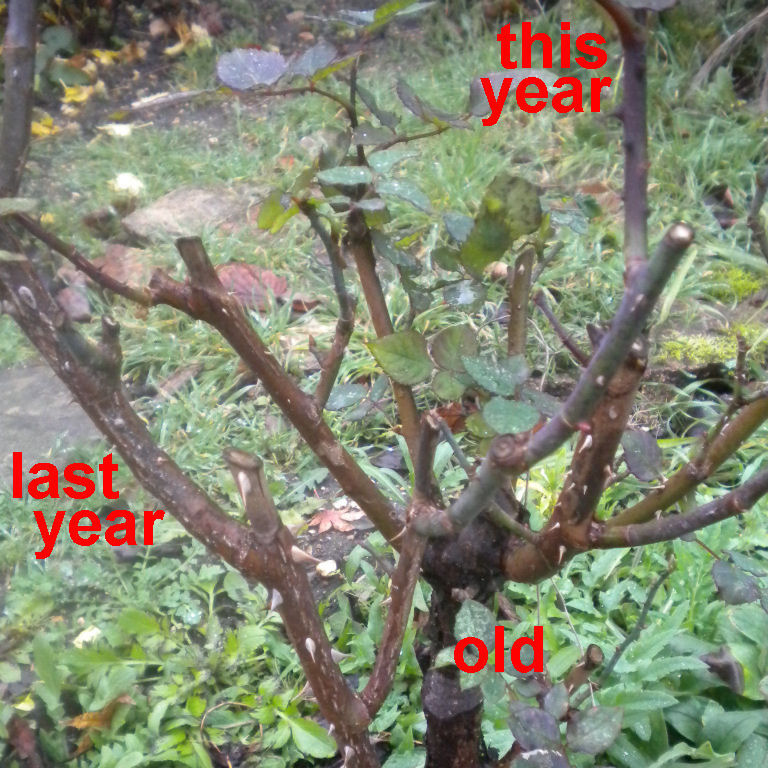 Pruning
Pruning


 Pruning
Pruning

Pruning means cutting bits off a plant, usually with secateurs, and there are various reasons to do this. It's worthwhile working out which you are doing (perhaps more than one!) as it can help you work out what to cut off.
Plants grow. Yes - obvious, but it's surprising how often this gets overlooked. If you have an annual, it will grow, but die at the end of the year, so that doesn't matter. Most perennials grow during the year, then die back at the end of the year. Their roots survive, and new growth starts from the ground, so they are usually easy to control as well. But trees and bushes (including roses) don't die back. They may lose their leaves, but every year they carry on growing where they left off last year. So every year the plant gets bigger. If you have a fruit tree, you may end up with the fruit out of reach! The roses may blossom only on top of the bush. And in some cases, the plant starts to take over a substantial part of the garden, and you want to get rid of a lot of it!
Wisteria is vigorous and definitely needs controlling. I describe its pruning on its own page.
The most obvious example of this is topiary, where you shape a bush into shape. I have a chicken made of box, for example.
Sometimes you can alter the shape in a simpler way. You can make a tree rather than a bush, by pruning the sideways branches. Or you can make a plant which growing straight upwards bushier by cutting off the top branch. You may want to make fruit bushes more open (especially if they have spines!) to get at the fruit easier. Or some dratted plant is growing all over the path, or into your neighbour's garden, or smothering another plant. Cut it back!
This sounds very strange. How can you stimulate growth by cutting bits off? Well, that's what happens (usually). A plant is not like an animal. When you cut part of a branch off, something called a dormant bud starts growing another branch. If you have an overgrown rose bush or apple tree, the growth is all happening at the top of the tree, and it can be spindly. However, if you cut it back, then the new growth happens further down the stem or trunk. As it is closer to the root of the plant, it tends to be more vigorous growth.
Some trees and bushes are grafted. This means that each is made up of two (or more) plants. One plant is the root stock, and this gives the vigour of the plant. Its top is cut off when young, and the root is stuck onto the top half of another plant, which gives the fruit and leaves and shape of the plant. Top and root stock grow together. You may be able to see a lump in the trunk where this happens, usually near the ground. The relevance of this to pruning is that grafted trees can produce suckers. These are shoots growing from the root stock, rather than from the top part of the plant. They look odd because they are different to the rest of the plant, with different leaves. Remove suckers when they appear, as close to the ground as possible. If allowed to grow, they will take energy from the rest of the plant, and may take it over altogether.
It's useful when pruning to work out the difference between growth this year (new wood) and growth in previous years (old wood). You may even be able to work out the difference between last year and this year's growth. There is also dead wood. Here are photos of some roses:


Dead wood is the least important. It is dead, and nothing will grow from it. On the other hand, it won't harm the plant. You can remove it to tidy the plant up, if you want. You can tell dead wood because it is greyish brown all the way through, and (if thin enough) breaks with a snap.
Old wood will be closest to the root. Its surface may well look more like bark. If you tried to break it, it may bend, then break.
New wood will have a much smoother surface. The colour varies. If you look at the photos above, one rose has green new wood, while the other has reddish new wood. You might also be able to see the difference between this year's growth, and last year's, which is starting to look more like old wood.
So why is this useful? Generally speaking, it is OK to prune new wood. Don't take off all new wood. The cut end can "die back" an inch or so, and leaving some new wood means this die-back stays within the new wood, and new shoots can still grow from that new wood.
I've heard of one exception to pruning new wood. Plum trees fruit on new wood, so if you're not careful, your pruning destroys any chance of getting any fruit! I don't know how you prune plum. Apple and pear trees fruit on old wood, so you can prune their new wood quite heavily without reducing the crop.
Pruning old wood needs more care. Some plants should not be pruned into old wood, becase their old wood doesn't regrow. I've found this seems to be true of herbs. Cut back lavender too much, and whole branches, or even the whole plant, can die. Other plants such as roses can produce new shots from old wood. I managed to regenerate my 40 year old rose that way! However old wood is riskier to prune. I hope it will work, but I'm not as confident as I would be for new wood. Another reason for care in pruning old wood is connected with fruit trees. The fruit spurs (which is where the blossom and fruit grows) form on old wood. Cut that off, and you might get less fruit.
So why would you want to prune old wood? Perhaps the tree has just grown too big, and you want to reduce its size. Or perhaps it has grown lop-sided and you want to take off one of the branches. Perhaps you want to try and regenerate an elderly rose bush, and prepared to take a chance that it will regrow. It is riskier, and you may find that it takes a year or more to regrow enough to produce flowers or fruit. But sometimes you just have to!
Pruning cuts off stuff, and if you prune at the wrong type of year, then you might cut off useful stuff. As a rule of thumb, I prune after the plant has produced the flowers or fruit that I want. That means that you can get the bush or tree ready for next year, and it reduces the chance of cutting off buds that you will actually want.
There are exceptions. I have an apple tree which sends out loads of growth while the apples are ripening on the tree, and I've started pruning it then, in summer. I want the tree to put its energy into forming and ripening the apples, not growing branches! It also makes it easier to find the apples later. But it's rather unorthodox.
I prune my roses in autumn, once the second flowering has finished. However I've found that if I prune them in summer as well, after the first flowering, and give them a good dose of fertiliser both times, this seems to encourage the roses, and I get an excellent second flowering, which I didn't used to.
You don't need to know about dormant buds, but you might find it interesting, because it explains why pruning works.

If you look carefully at a stem, you might find these dormant buds. There may be a line across the stem, and a small blip. It certainly doesn't look like anything that would ever grow! However, if you prune close to the dormant bud, it becomes active and starts sprouting. It doesn't look much at the start, but this will turn into a fully grown stem. Some people carefully find these dormant buds and notice which way they are facing, because then (hopefully) they will grow a stem in that direction. I don't. This is partly because of die-back, where you lose an inch or so from the cut part, and if that includes the dormant bud, then it won't sprout! But this is what gardening instructions mean when they talk of "prune to an outward facing bud". This type of instruction makes pruning sound hard, and it really isn't. Cut off what you don't want, and watch the plant regrow. If it doesn't, then you've learned something!
© Jo Edkins 2020 - Return to Garden index